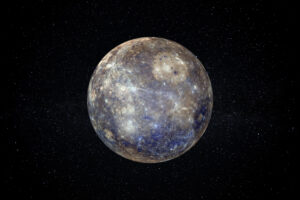An article published in the digital version of the scientific journal Icarus reports that pieces of mercury may have been found in the Earth. Two meteorites analyzed by British researchers present characteristics that indicate a possible origin on the planet closest to the Sun.
If confirmed, this will be the first record of mercurial rocks on terrestrial soil, offering a rare opportunity for study.
To this day, no space mission has brought samples from the surface of Mercury. The only probes that came close were Mariner 10 and Messenger, both from NASA, who were only flying over the planet. A controlled landing would be technically complex and financially expensive, with a trip that can take up to seven years to complete.
It is more difficult to reach mercury than in Pluto
According to highlight The European Space Agency (ESA), reaching mercury is harder than reaching more distant planets, such as Jupiter or even Pluto. The main barrier is the intense gravity of the sun. Any ship that tries to orbiting mercury needs to stop constantly so as not to be pulled by our host star. This requires a lot of fuel or the use of gravitational maneuvers involving other planets.
“To be able to reduce the speed, it is necessary to make several approach flights through other planets along the way,” explained Johannes Benkhoff, scientist at ESA responsible for the Becolombo mission. This long trajectory and the high temperatures near the sun make the mission even more challenging.
Therefore, the possibility that fragments of mercury have arrived spontaneously to Earth is seen as a great scientific advantage. Meteor impacts may have launched mercury surface debris into space. These pieces then wandered through the solar system until they crossed the orbit of the earth, falling like meteorites.
According to NASAMercury, like the moon, is covered by numerous craters caused by collisions with asteroids and comets. However, there has never been an official confirmation of a mercurian meteorite found on Earth. For the researchers, this was a mystery that lasted decades.
Now the Ksar Ghilane 022 and Northwest Africa 15915 meteorites are being considered the first promising candidates. They contain minerals such as olivine, piroxénium and oldhamita, which combine with what is already known about the mercury crust. “Its surface mineralogy and composition also exhibit intriguing similarities to the Mercury crust. This led us to speculate about a possible mercurian origin,” reveals the main author of the study, Ben Rider-Stokes, a postdoctoral researcher in meteorites in Open University, England, to the website The Conversation.
However, scientists prefer to maintain caution. One detail that generates doubt is the low amount of plagioclasio in the meteorites, while Mercury has a surface rich in this mineral. Another intriguing point is the age of samples: it is estimated that they are about 4.528 billion years, which makes them older than the older surfaces visible in Mercury.
Read more:
Bepicalombo Mission can unravel the mystery
This difference raises questions about the planet’s past. In an interview with the site Space.comSimone Marchi, from the NASA Institute of Lunar Sciences, recalls that Mercury may have lost part of its initial geological history.
“If the oldest surface visible in Mercury is 4 billion or 4.1 billion years, this would imply that the first 500 million or 400 million years of the planet have been erased,” says Marchi. “There is no record of the older surface of Mercury, and we hope it has practically formed like the earth or the moon, about 4.5 billion years ago.”
According to Rider-Stokes, this does not necessarily discard that the rocks came from the planet. He believes that meteorites may have come from deep regions or parts of the crust that no longer exist on the current mercury surface.
More answers may come soon. In 2026, the Becolombo Mission, a partnership between ESA and the Japanese Aerospace Exploration Agency (JAXA), will enter the orbit of Mercury. Scientists expect new data to help better compare the characteristics of the planet’s surface with those of the meteorites found on Earth.











